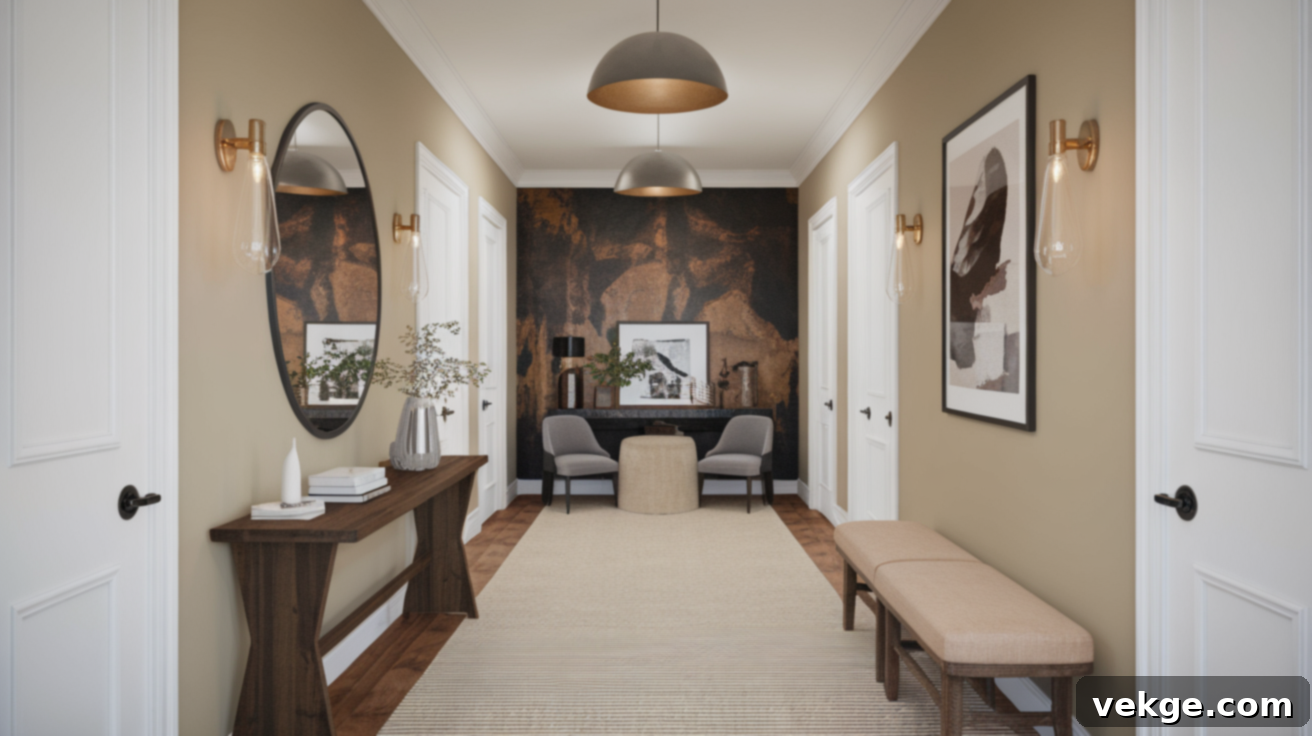Transform Your Hallway: Creative Design Ideas for the End of Your Hallway
Is your hallway feeling plain, underused, or simply lacking that inviting spark? The end of the hallway is a frequently overlooked area, yet it holds immense potential to become a true design highlight in your home. With just a few thoughtful design ideas, you can elevate this transitional space into something both highly functional and aesthetically pleasing.
In this comprehensive guide, we’ll delve deep into how to maximize the end of your hallway, offering innovative solutions for enhancing storage, playing with color, incorporating unique decor, and even creating new functional zones. Whether you’re looking to infuse personality with bold colors, make the space more practical with clever storage options, or carve out a cozy retreat, you’ll find an abundance of inspiration to bring this often-neglected area to vibrant life. Ready to unlock your hallway’s full potential? Let’s explore the possibilities!
Why the End of the Hallway is Important
The end of the hallway often serves as a natural focal point within your home. It’s frequently the first spot visitors truly observe as they journey through your living spaces, making it crucial for setting a lasting first impression. The design choices you make here can significantly influence the overall ambiance of the entire hallway, determining whether it feels expansive and welcoming or more defined and intimate. By thoughtfully designing this specific area, you can establish the aesthetic tone for the rest of the hallway and even for the adjacent rooms.
A well-designed end of the hallway also plays a key role in tying together the overall narrative of your home’s interior design. It ensures a smooth visual flow into other spaces, acting as a natural transition point. Whether through a coordinated color palette, a carefully selected piece of furniture, or curated decor, this area can serve as a vital visual connector, linking various elements of your home’s design and creating a cohesive, harmonious environment. It’s an opportunity to extend your personal style beyond individual rooms and into the circulatory heart of your home.
Innovative Design Ideas for the End of Your Hallway Decor
The end of the hallway is a prime spot for creating an eye-catching design that can truly elevate the entire space. With a few innovative touches, you can transform this often-overlooked area into a stylish, functional, and memorable part of your home, setting an inviting tone for everyone who passes through.
Create a Feature Wall
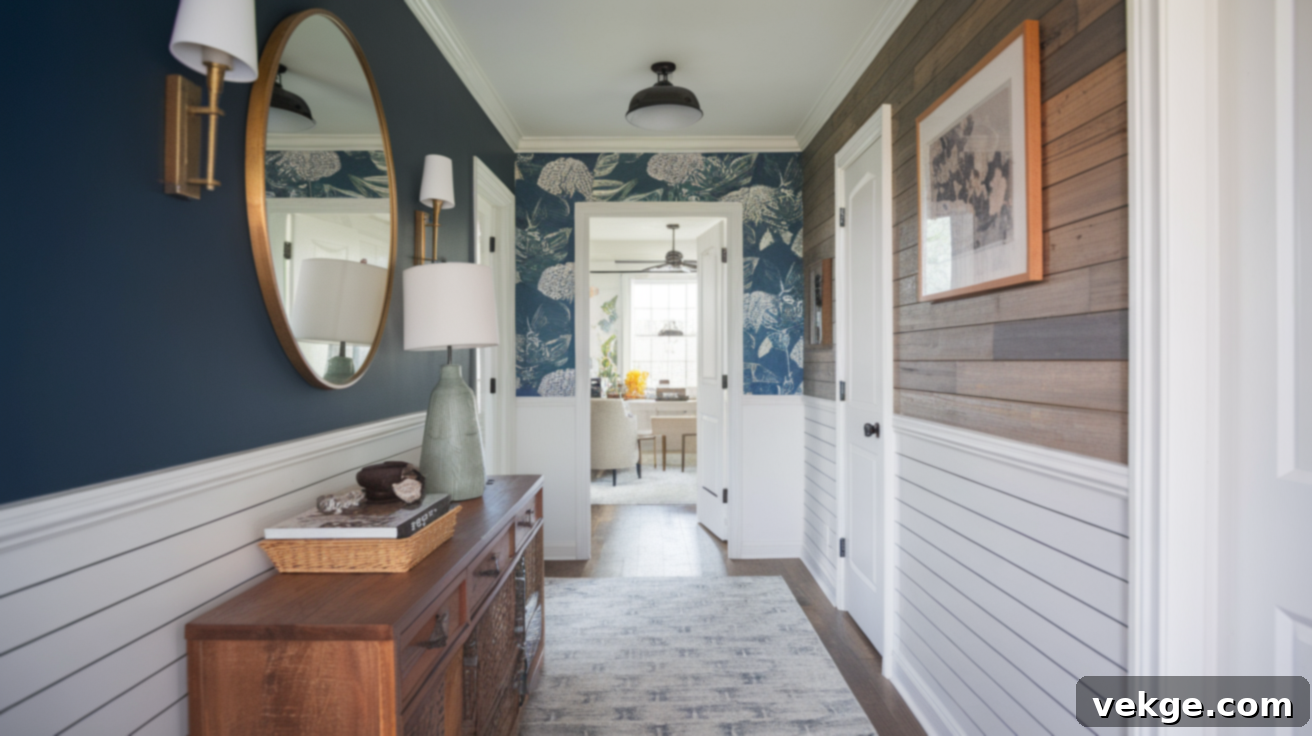
A feature wall at the end of the hallway can dramatically transform the space with surprisingly minimal effort. Consider using bold colors, such as a sophisticated navy, a deep forest green, or a rich charcoal gray, to make the wall instantly stand out and create depth. Alternatively, patterns like classic stripes, modern geometric shapes, or even an accent wall with a textured paint effect can add significant visual interest and a unique personality.
For those seeking more elaborate designs, wallpapers featuring elegant floral prints, whimsical patterns, or even a custom mural can introduce a striking artistic element, bringing personality and narrative depth to the area. If you prefer a more natural, tactile look, consider installing reclaimed wood planks, shiplap, or even decorative wall panels. These textures can evoke a rustic charm or a coastal vibe, helping to create a welcoming and warm atmosphere that naturally draws attention to the end of your hallway. Remember, the goal is to make a statement that reflects your personal style.
Statement Furniture
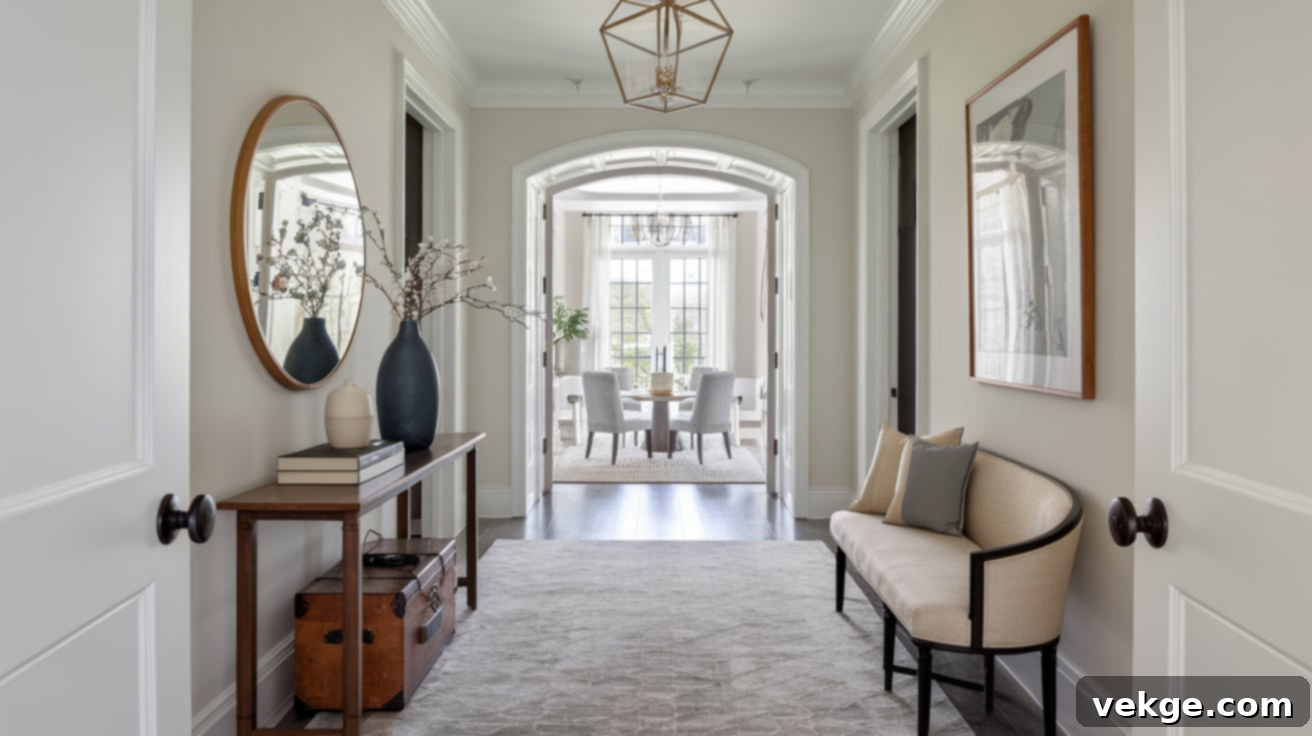
A carefully chosen statement piece of furniture can add both style and crucial functionality to the end of your hallway. A sleek, minimalist console table, for example, is an excellent option for modern and contemporary spaces. It provides a sophisticated surface to display a striking vase of fresh flowers, an abstract sculpture, a collection of art books, or other decorative items, all while maintaining a clean aesthetic. When selecting a console, consider its material – perhaps a warm wood for a traditional feel, or glass and metal for an industrial edge.
For additional seating and a more inviting atmosphere, a stylish bench or a pair of accent chairs can transform the space into a small, welcoming waiting area or a place to put on shoes. Add plush cushions or a soft throw to enhance comfort and visual appeal. For a dual-purpose solution that marries style with practicality, a storage bench or a decorative trunk offers both aesthetic charm and valuable hidden storage. This helps to keep your hallway clutter-free by stowing away items like shoes, bags, or extra blankets, while simultaneously adding a touch of elegance and charm to the area.
Add a Mirror

Mirrors are incredibly versatile and effective tools for enhancing the end of any hallway. An oversized mirror, especially one that spans a significant portion of the wall, can work wonders by reflecting natural and artificial light. This not only makes the space feel considerably more expansive and brighter, but also adds a touch of glamour. Beyond its aesthetic benefits, a large mirror serves a practical purpose, allowing you and your guests to quickly check appearances before heading out the door.
If you’re looking for something more unique or artistic, consider decorative mirrors with interesting frames. Whether you opt for a vintage ornate gold frame, a rustic wooden frame, a sleek industrial metal frame, or a contemporary geometric design, the frame itself can become a powerful personal touch. These mirrors don’t just reflect light; they can become a stylish focal point that complements the hallway’s overall design, helping to tie together the surrounding decor and adding a layer of sophisticated visual interest. They are a simple yet impactful way to enhance both the beauty and functionality of the space.
Utilize Artwork or Photography
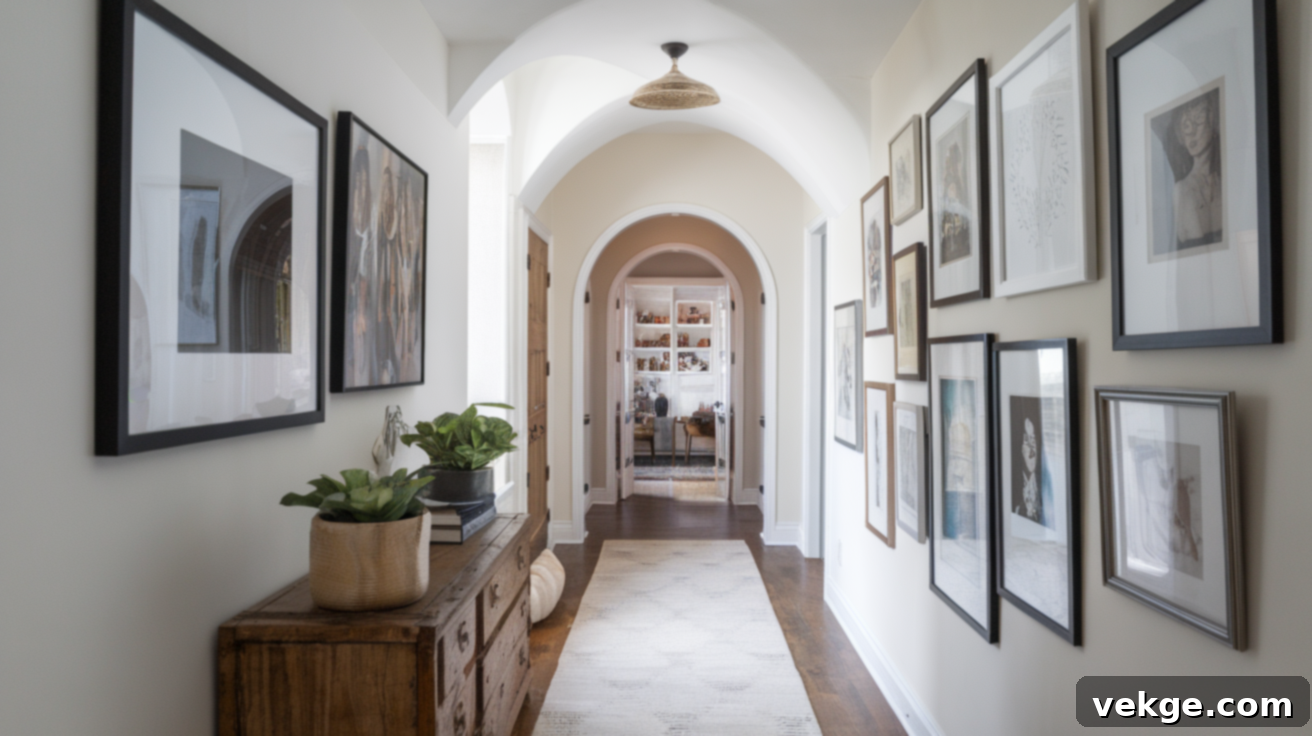
Adding thoughtfully selected artwork or photography to the end of the hallway is an excellent way to inject personalized character and style. A gallery wall, featuring a curated collection of framed art, cherished family photos, or interesting prints, can add personality and give the space a distinct, narrative vibe. Experiment with mixing different frame styles, sizes, and orientations for an eclectic look, or opt for a consistent theme across the images and frames to create a more cohesive and sophisticated display.
Alternatively, a single large piece of artwork or a bold, impactful photograph can become the undisputed centerpiece of the space. Such a statement piece immediately draws attention and can serve as a powerful visual anchor, breaking up the monotony of a plain hallway and adding a dramatic focal point. This design choice not only enhances visual interest but also reflects your tastes and passions, turning a simple passageway into a gallery-like experience within your home.
Play with Lighting
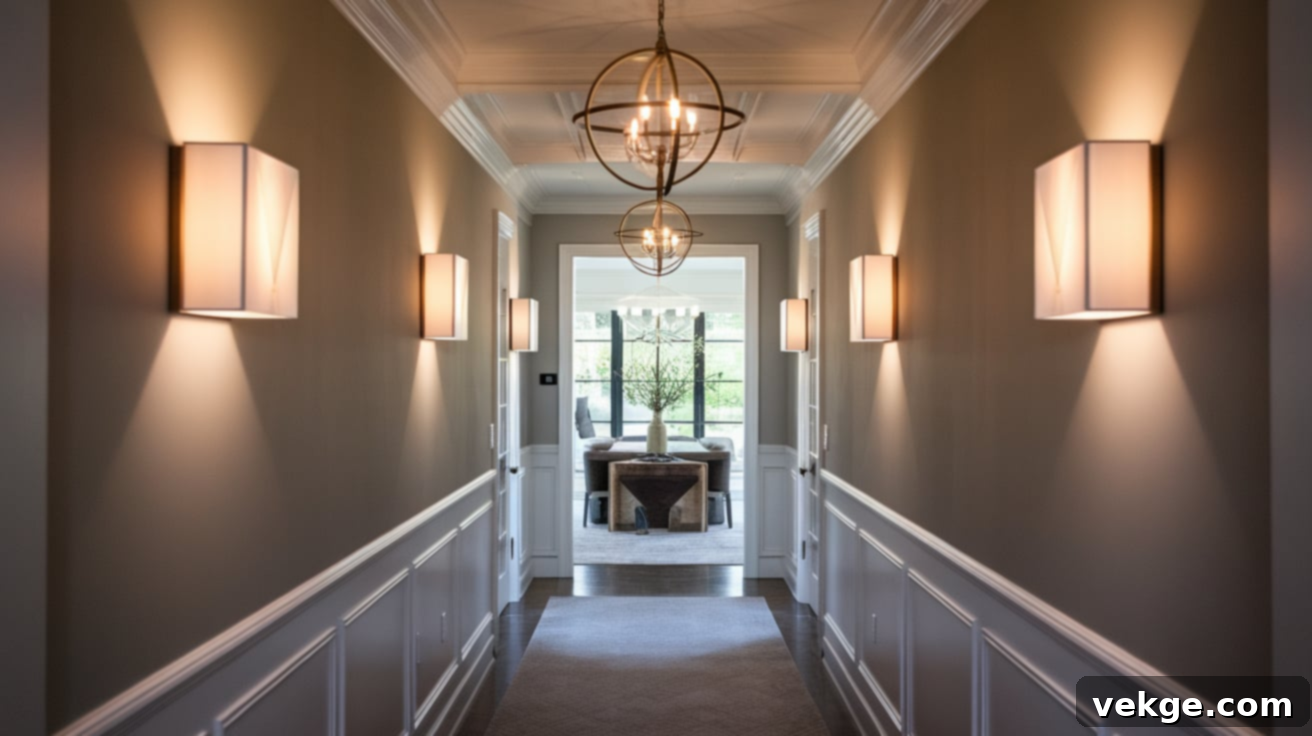
Lighting is a pivotal element that can significantly alter the appearance and ambiance of the end of the hallway. Strategic lighting can transform a dark, uninviting space into a warm, welcoming area. Consider installing an elegant pendant light or a striking chandelier as a stylish focal point that not only illuminates the space but also adds a touch of grandeur or modern flair. These fixtures come in an extensive variety of designs, from contemporary geometric shapes to traditional crystal arrangements, allowing you to match your home’s aesthetic and create a specific mood.
Wall sconces are another fantastic lighting option, offering soft, ambient light that adds warmth and sophistication to the hallway. Place them strategically along the wall to create a gentle glow, highlight artwork, or define the space. For a more subtle effect, recessed lighting can provide general illumination without visual clutter. A well-lit hallway always feels more inviting, open, and thoughtfully designed, enhancing the overall comfort and beauty of your home.
Incorporate Greenery
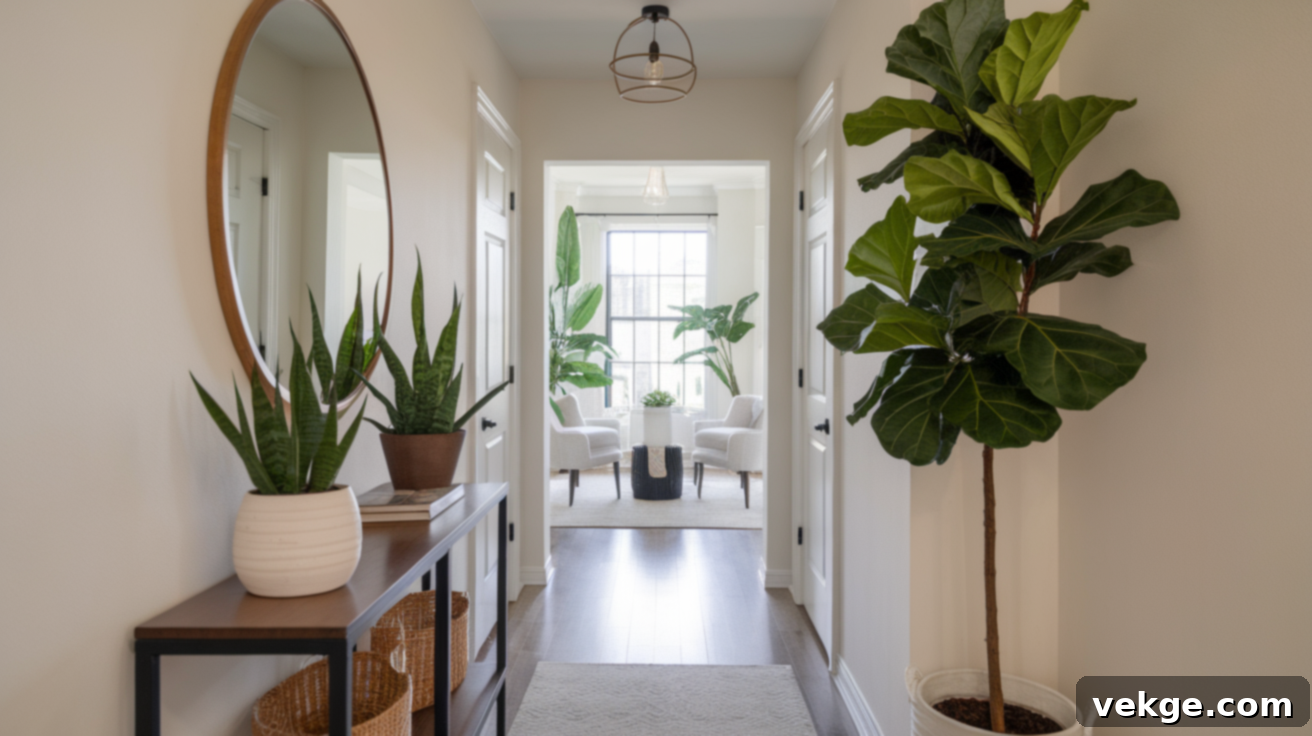
Incorporating greenery at the end of your hallway is a wonderful way to bring life, freshness, and a vibrant touch to the space. Tall indoor plants, such as a majestic fiddle-leaf fig, a resilient rubber tree, or a sleek snake plant, can gracefully fill the vertical space without overwhelming the area. These larger plants not only add a significant natural element but also contribute to air purification, improving the indoor environment.
For smaller hallways or more confined spaces, consider smaller planters placed on a console table, shelves, or even hanging baskets. Delicate ferns, trailing ivies, or colorful flowering plants can introduce greenery without taking up precious floor space. Whether you choose large, architectural plants or a collection of smaller, charming potted greens, plants instantly add a sense of tranquility, vibrancy, and a welcoming feel to the end of your hallway. They connect your indoor space with nature, creating a calming and appealing transition zone.
Maximizing Storage at the End of the Hallway
The end of the hallway is an often-underutilized location that presents an ideal opportunity for adding extra storage without sacrificing style. With the right design choices, you can make this area significantly more functional and organized, helping to keep your entire home clutter-free while maintaining a clean and cohesive aesthetic. Smart storage solutions can truly transform a simple pass-through into a highly efficient space.
Built-in Cabinets or Shelves
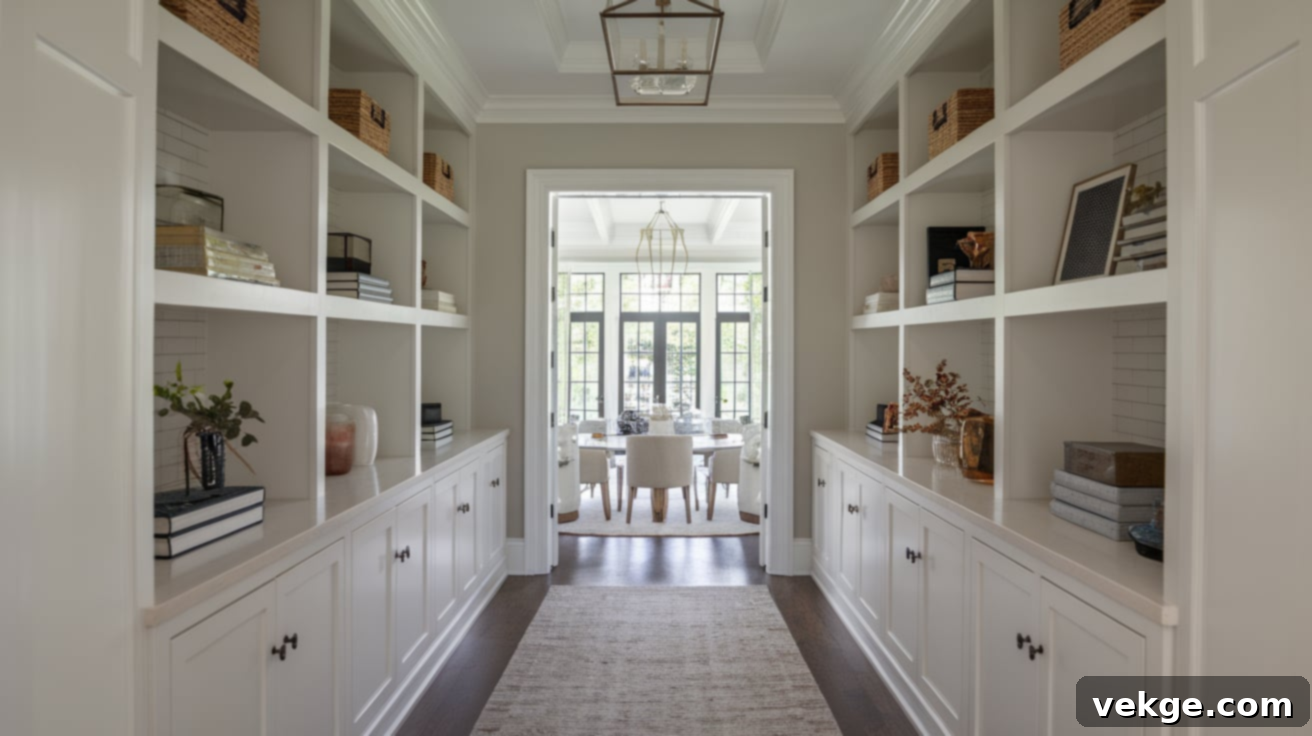
Built-in cabinets or shelves are an exceptionally efficient way to utilize the space at the end of the hallway for additional storage. These custom-designed pieces can be precisely tailored to fit the exact dimensions of your space, offering a seamless, integrated look that appears as though it was always part of the home’s architecture. Built-in shelves provide a practical and accessible solution for storing books, displaying decorative items, or keeping everyday essentials like keys, mail, and small bags neatly organized and within reach.
If you require more substantial storage or prefer a tidier appearance, cabinets with doors are ideal for concealing items such as shoes, hats, gloves, or even cleaning supplies, thereby keeping the space impeccably tidy and clutter-free. This type of custom storage can be designed to blend harmoniously into the hallway’s existing style, offering extensive storage capacity without occupying unnecessary floor space or creating a bulky appearance. It’s a sophisticated way to add functionality to your hallway.
Coat Racks or Hooks
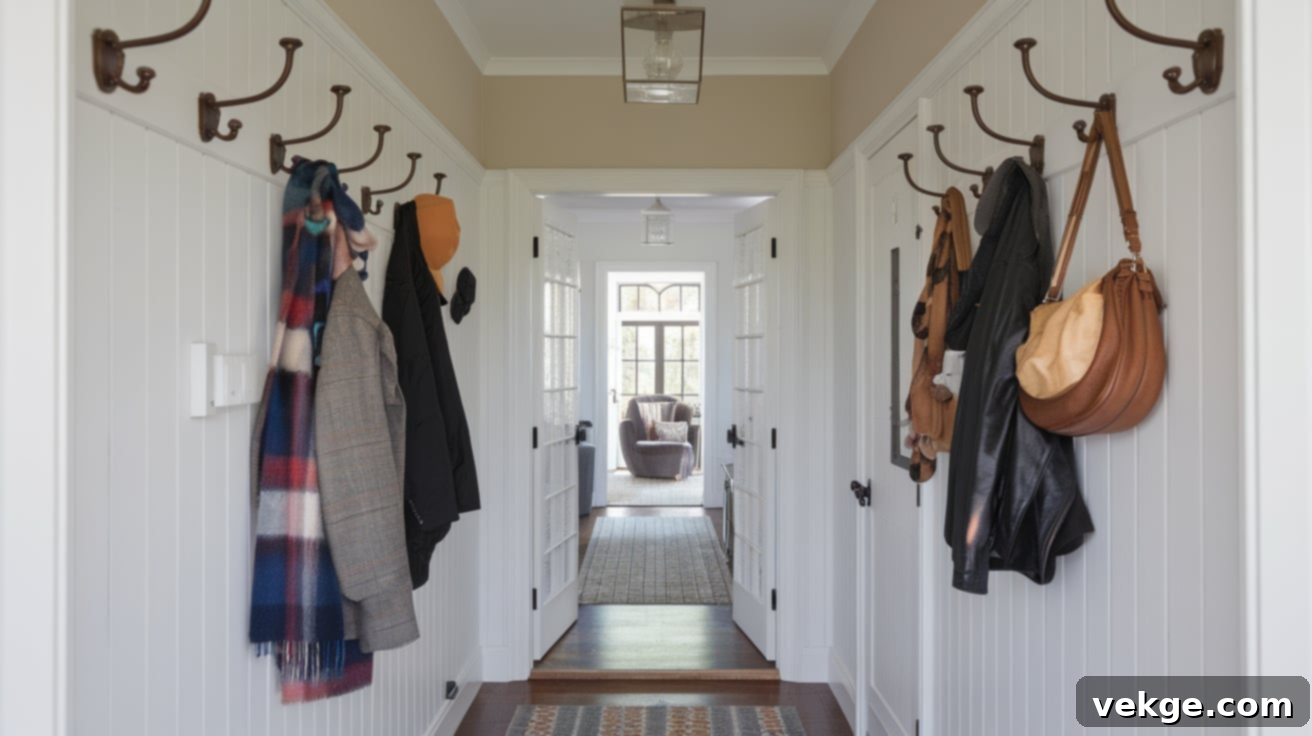
For a simple yet highly effective storage solution, coat racks or hooks at the end of the hallway offer an indispensable way to keep your outerwear, bags, and accessories organized and easily accessible. Wall-mounted hooks, available in various styles from minimalist to rustic, or a freestanding coat rack can be strategically placed to provide a convenient spot for hanging jackets, coats, hats, scarves, and purses. This keeps these items off furniture and floors, preventing clutter from accumulating in other areas of your home.
To achieve a more refined and intentional look, select hooks or a coat rack made from materials that complement your hallway’s existing design. Options include warm woods for a classic feel, sleek metals for a modern touch, or even colorful ceramic hooks for a playful accent. This practical addition ensures that daily essentials are always within reach as you come and go, while simultaneously maintaining a neat and welcoming entryway or hallway transition space.
Functional Uses for the End of the Hallway
The end of the hallway doesn’t have to be merely a passageway; it can be reimagined as a dynamic and functional extension of your living space, significantly improving your home’s utility and comfort. Whether you envision a tranquil spot to unwind with a book or a compact yet efficient workspace, these creative design ideas can help you make the absolute most of this often-overlooked area, transforming it into a cherished part of your home.
Create a Reading Nook
Transforming the end of the hallway into a cozy and inviting reading nook can offer a peaceful retreat from the hustle and bustle of daily life. Begin by adding a comfortable, perhaps compact, armchair or a small upholstered bench adorned with soft cushions and a cozy throw blanket, perfect for curling up with a good book. Ensure the seating is inviting and proportionate to the space.
Integrate a small side table or a slim wall-mounted shelf to hold a cup of tea or coffee, and provide essential reading light with a stylish floor lamp or strategically placed wall sconce. For added charm and functionality, consider incorporating built-in bookshelves or wall-mounted shelving above the seating area to display your favorite books and a few decorative accents. A soft, small rug placed beneath the chair will enhance comfort and define the space, making this intimate corner an ideal and inviting place to relax, unwind, and escape into a literary adventure.
Home Office Corner
Maximizing your home’s potential often means finding innovative uses for every available inch, and the end of the hallway can be an ideal spot for a functional home office corner. A compact desk, such as a wall-mounted floating desk or a space-saving corner desk, can fit neatly into this area without overwhelming the flow of traffic. Choose a design that complements the existing decor to maintain visual harmony.
Pair the desk with a comfortable, ergonomic chair and essential task lighting, such as a desk lamp, to create a productive and well-illuminated work environment. If additional storage is required for office supplies, files, or electronics, consider installing shelves above the desk or integrating slim drawers underneath. For those who desire more privacy or to minimize distractions, the use of a stylish room divider, a decorative screen, or even a chic curtain can help separate the workspace from the rest of the home. This clever use of space not only maximizes a small area but creates a dedicated, efficient work zone where productivity can flourish.
Hallway Flooring at the End
The flooring chosen for the end of the hallway plays a crucial role in tying together the overall design aesthetic of your home. Whether you opt to continue the same flooring material from the main hallway or introduce an area rug to define and soften the space, making the right flooring choices can significantly improve the visual flow of the hallway and connect it seamlessly with the rest of your home. It’s a foundational element that impacts both style and perception of space.
Continuing the Flooring Theme
One of the most effective ways to maintain cohesion and create a sense of spaciousness in your hallway design is by continuing the same flooring material all the way to the end. Utilizing the same wood, tile, laminate, or vinyl planks throughout the entire hallway creates a smooth, uninterrupted visual line. This approach visually elongates the space, making the hallway feel significantly larger, more open, and effortlessly connected to the surrounding rooms. It creates a seamless transition that guides the eye.
If you wish to add extra definition or a touch of warmth to the end of the hallway while still maintaining flooring continuity, consider placing a well-chosen area rug. A rug can introduce texture, color, and pattern, creating a soft landing spot or a visual anchor, without breaking the continuous flow of the underlying flooring material. This simple addition can infuse warmth and character into the space, offering comfort underfoot and enhancing the overall welcoming feel of your hallway.
Flooring Transitions
When transitioning from the hallway into adjacent rooms, selecting a flooring option that blends seamlessly while clearly defining each space is essential for a polished look. If you are switching between different flooring materials, such as moving from hardwood in the hallway to tile in a kitchen or bathroom, it’s crucial to use a high-quality transition strip or threshold. These elements create a smooth and visually pleasing change, preventing an abrupt or awkward shift between materials and ensuring a continuous, safe flow underfoot.
Another excellent option is to use a consistent flooring material throughout the entire hallway and extend it into the adjacent room. For example, continuing the same wood flooring from the hallway directly into the living room, dining area, or bedroom can create a highly unified and open feel. This strategy not only enhances the sense of spaciousness but also creates a cohesive design narrative that visually expands your home’s footprint and establishes a sophisticated, harmonious aesthetic throughout. Thoughtful transitions are key to a professional finish.
Common Mistakes to Avoid
When embarking on designing the end of your hallway, it’s easy to make a few common mistakes that can negatively impact the overall flow, functionality, and aesthetic appeal of the space. By being aware of these pitfalls, you can ensure that your hallway’s end is not only stylish and inviting but also practical and harmoniously integrated into your home.
- Overcrowding the Space: A frequent mistake is to overload the end of the hallway with too much furniture, decor, or too many large items. Hallways are inherently transitional spaces, and excessive clutter can make them feel cramped, claustrophobic, and impede movement. Always prioritize scale and proportion, ensuring any additions fit comfortably without blocking the pathway or overwhelming the visual space. Keep it simple and allow room to breathe.
- Ignoring Lighting: A lack of proper lighting can make the end of the hallway feel dark, dim, and uninviting, especially if it’s meant to be a focal point. Poor lighting can also make the space seem smaller and less appealing. Ensure the area is well-lit with a combination of ambient, task, and accent lighting if possible. A single overhead light might not be enough; consider adding a wall sconce, a decorative table lamp on a console, or even a floor lamp to create warmth and depth.
- Clashing Colors: While bold colors can create a dramatic feature wall, using too many conflicting or intense colors that clash with the rest of your home’s existing palette can create visual chaos and detract from a harmonious design. Instead, stick to a cohesive color scheme that complements the adjacent rooms. You can introduce pops of color through accessories or a single statement wall, but ensure they work with the overall flow and do not introduce jarring contrasts.
- Forgetting Practicality: Aesthetics are undoubtedly important, but don’t neglect the essential functionality of the hallway. Any storage, seating, or decorative elements you add should ideally serve a practical purpose or at least not hinder the use of the hallway. Forgetting practicality can lead to beautiful but unusable spaces. For instance, a bench is great for sitting, but if it’s too wide, it obstructs passage. Always balance form with function.
- Using Too Many Patterns: Combining too many conflicting patterns, especially in a confined space like a hallway end, can overwhelm the eye and make the area feel busy and chaotic. If you’re using patterned wallpaper, balance it with solid-colored furniture and decor. Opt for one main pattern (e.g., on a rug or wallpaper) and complement it with subtle textures or neutral tones in other elements to create a sophisticated and cohesive look rather than a jumbled one.
Conclusion
Now that you’re armed with a wealth of fresh, innovative ideas for the end of your hallway, it’s time to take the plunge and start transforming this often-overlooked space into a true asset for your home. Remember, whether it’s by strategically adding practical storage, crafting a cozy and inviting reading nook, or simply enhancing the area with thoughtful color, texture, and lighting choices, even small changes can dramatically impact the feel and functionality of this crucial transitional zone.
The end of your hallway has immense potential to become both a highly functional and beautifully stylish area, significantly improving the overall flow, aesthetic, and welcoming atmosphere of your entire home. It’s an opportunity to extend your personal style and make every corner count. Ready to add your unique personal touch and truly elevate your living experience? Explore our other blogs for even more home design inspiration, practical tips, and creative solutions to ensure your space always looks its absolute best!
